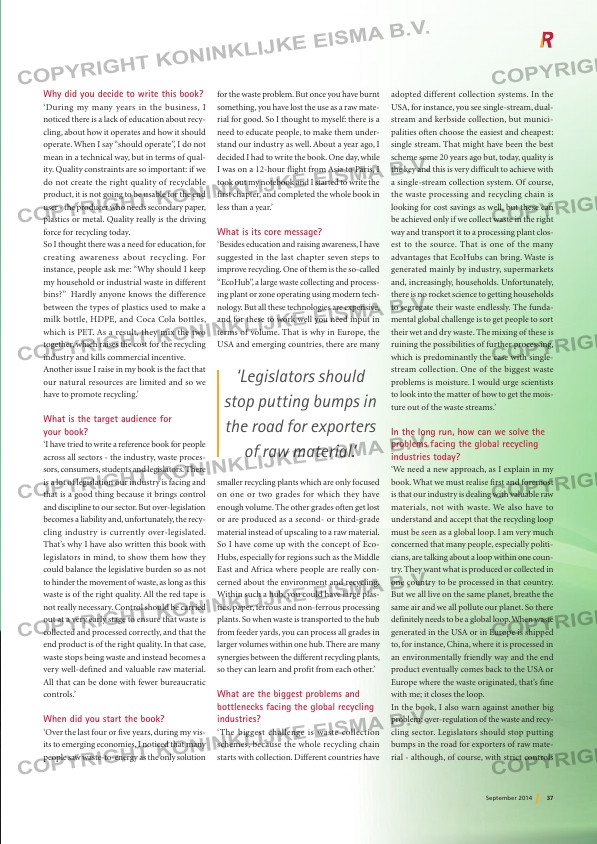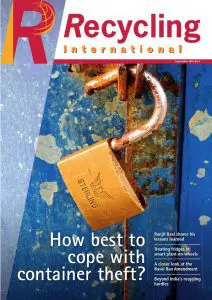Page 37 from: September 2014

37September 2014
Why did you decide to write this book?
‘During my many years in the business, I
noticed there is a lack of education about recy-
cling, about how it operates and how it should
operate. When I say “should operate”, I do not
mean in a technical way, but in terms of qual-
ity. Quality constraints are so important: if we
do not create the right quality of recyclable
product, it is not going to be usable for the end
user – the producer who needs secondary paper,
plastics or metal. Quality really is the driving
force for recycling today.
So I thought there was a need for education, for
creating awareness about recycling. For
instance, people ask me: “Why should I keep
my household or industrial waste in different
bins?” Hardly anyone knows the difference
between the types of plastics used to make a
milk bottle, HDPE, and Coca Cola bottles,
which is PET. As a result, they mix the two
together, which raises the cost for the recycling
industry and kills commercial incentive.
Another issue I raise in my book is the fact that
our natural resources are limited and so we
have to promote recycling.’
What is the target audience for
your book?
‘I have tried to write a reference book for people
across all sectors – the industry, waste proces-
sors, consumers, students and legislators. There
is a lot of legislation our industry is facing and
that is a good thing because it brings control
and discipline to our sector. But over-legislation
becomes a liability and, unfortunately, the recy-
cling industry is currently over-legislated.
That’s why I have also written this book with
legislators in mind, to show them how they
could balance the legislative burden so as not
to hinder the movement of waste, as long as this
waste is of the right quality. All the red tape is
not really necessary. Control should be carried
out at a very early stage to ensure that waste is
collected and processed correctly, and that the
end product is of the right quality. In that case,
waste stops being waste and instead becomes a
very well-defined and valuable raw material.
All that can be done with fewer bureaucratic
controls.’
When did you start the book?
‘Over the last four or five years, during my vis-
its to emerging economies, I noticed that many
people saw waste-to-energy as the only solution
for the waste problem. But once you have burnt
something, you have lost the use as a raw mate-
rial for good. So I thought to myself: there is a
need to educate people, to make them under-
stand our industry as well. About a year ago, I
decided I had to write the book. One day, while
I was on a 12-hour flight from Asia to Paris, I
took out my notebook and I started to write the
first chapter, and completed the whole book in
less than a year.’
What is its core message?
‘Besides education and raising awareness, I have
suggested in the last chapter seven steps to
improve recycling. One of them is the so-called
“EcoHub”, a large waste collecting and process-
ing plant or zone operating using modern tech-
nology. But all these technologies are expensive,
and for these to work well you need input in
terms of volume. That is why in Europe, the
USA and emerging countries, there are many
smaller recycling plants which are only focused
on one or two grades for which they have
enough volume. The other grades often get lost
or are produced as a second- or third-grade
material instead of upscaling to a raw material.
So I have come up with the concept of Eco-
Hubs, especially for regions such as the Middle
East and Africa where people are really con-
cerned about the environment and recycling.
Within such a hub, you could have large plas-
tics, paper, ferrous and non-ferrous processing
plants. So when waste is transported to the hub
from feeder yards, you can process all grades in
larger volumes within one hub. There are many
synergies between the different recycling plants,
so they can learn and profit from each other.’
What are the biggest problems and
bottlenecks facing the global recycling
industries?
‘The biggest challenge is waste collection
schemes, because the whole recycling chain
starts with collection. Different countries have
adopted different collection systems. In the
USA, for instance, you see single-stream, dual-
stream and kerbside collection, but munici-
palities often choose the easiest and cheapest:
single stream. That might have been the best
scheme some 20 years ago but, today, quality is
the key and this is very difficult to achieve with
a single-stream collection system. Of course,
the waste processing and recycling chain is
looking for cost savings as well, but these can
be achieved only if we collect waste in the right
way and transport it to a processing plant clos-
est to the source. That is one of the many
advantages that EcoHubs can bring. Waste is
generated mainly by industry, supermarkets
and, increasingly, households. Unfortunately,
there is no rocket science to getting households
to segregate their waste endlessly. The funda-
mental global challenge is to get people to sort
their wet and dry waste. The mixing of these is
ruining the possibilities of further processing,
which is predominantly the case with single-
stream collection. One of the biggest waste
problems is moisture. I would urge scientists
to look into the matter of how to get the mois-
ture out of the waste streams.’
In the long run, how can we solve the
problems facing the global recycling
industries today?
‘We need a new approach, as I explain in my
book. What we must realise first and foremost
is that our industry is dealing with valuable raw
materials, not with waste. We also have to
understand and accept that the recycling loop
must be seen as a global loop. I am very much
concerned that many people, especially politi-
cians, are talking about a loop within one coun-
try. They want what is produced or collected in
one country to be processed in that country.
But we all live on the same planet, breathe the
same air and we all pollute our planet. So there
definitely needs to be a global loop. When waste
generated in the USA or in Europe is shipped
to, for instance, China, where it is processed in
an environmentally friendly way and the end
product eventually comes back to the USA or
Europe where the waste originated, that’s fine
with me; it closes the loop.
In the book, I also warn against another big
problem: over-regulation of the waste and recy-
cling sector. Legislators should stop putting
bumps in the road for exporters of raw mate-
rial – although, of course, with strict controls
‘Legislators should
stop putting bumps in
the road for exporters
of raw material.’
Ranjit Baxi’s book:
‘ Recycling our future – a global strategy’
Words of education
and inspiration
RI-7 Interview.indd 37 28-08-14 15:09



